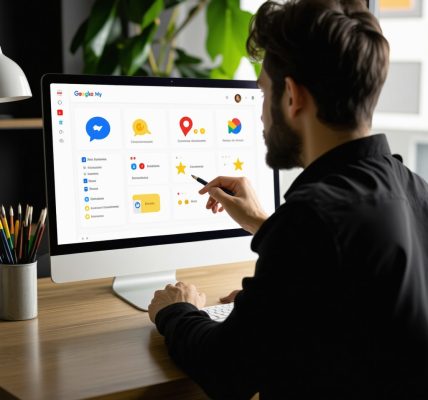Unlocking the Power of Keywords in Your GMB Business Description
In the competitive arena of local search, every word in your Google My Business (GMB) profile can tip the scales between obscurity and prominence. The business description section, often overlooked, is a strategic goldmine for embedding carefully selected keywords that enhance your local search visibility. When optimized expertly, these keywords not only improve rankings but also attract the right customers by clearly communicating your business’s unique value proposition.
Crafting a Magnetic GMB Description That Speaks Both to Algorithms and People
Integrating keywords into your GMB description demands a delicate balance between SEO finesse and authentic storytelling. Overstuffing keywords can trigger penalties or turn off potential clients, while underutilizing them misses critical ranking opportunities. Instead, craft your description with semantic relevance—incorporate Latent Semantic Indexing (LSI) keywords that relate naturally to your main search terms, such as “local services,” “trusted provider,” or specific niche terms relevant to your business type.
For example, a boutique bakery might include phrases like “artisan pastries,” “freshly baked bread,” and “custom cakes near me,” seamlessly woven into a compelling narrative about their commitment to quality and community.
How Can Strategic Keyword Placement in Your GMB Description Skyrocket Local Searches?
Understanding the nuanced role of keywords beyond mere repetition is essential. Google’s algorithms prioritize semantic context and user intent. Embedding keywords in the opening sentences of your description signals relevance immediately, while sprinkling variations throughout keeps the content rich and natural. Using tools like Google Keyword Planner can uncover high-impact local keywords that match real user queries, boosting your chances of appearing in the coveted local 3-pack.
Real-World Example: Turning Keywords into Local Leads
Consider a local HVAC company that revamped its GMB description by incorporating geo-specific keywords such as “HVAC repair in [City],” “emergency heating services,” and “energy-efficient air conditioning.” This strategic keyword integration, combined with regular content updates, resulted in a measurable increase in calls and bookings within just three months. This case underscores how thoughtful keyword strategy can translate into tangible business growth.
Expert Tip: Beyond Keywords — Maintain Your GMB Profile’s Freshness and Credibility
While keywords are pivotal, they work best within a robust profile that includes updated photos, accurate categories, and active review management. Engaging with customer reviews and ensuring your profile details are current builds trust and enhances your overall local SEO performance. For a comprehensive approach, explore how to optimize your Google Business listing effectively and GMB SEO audit techniques for continuous improvement.
According to Moz, local search ranking factors heavily weigh on proximity, relevance, and prominence — all areas where expertly placed keywords in your GMB description make a significant impact.[Source]
Ready to transform your local visibility? Share your experiences or questions below, and let’s elevate your Google My Business presence together!
Leveraging Semantic Keyword Clusters for Enhanced GMB Visibility
Beyond the foundational use of primary keywords, advanced optimization involves the strategic deployment of semantic keyword clusters. These clusters encompass groups of related terms that collectively enhance the topical authority of your GMB description. By integrating synonyms, related phrases, and niche-specific jargon, you create a richer content ecosystem that Google’s AI interprets as highly relevant to user queries.
For instance, a local landscaping business might incorporate terms such as “garden design,” “lawn maintenance services,” “eco-friendly landscaping,” and “seasonal planting near me”. This approach not only broadens the range of queries your listing can rank for but also improves the likelihood of capturing voice search queries, which tend to be more conversational and varied.
Optimizing Keyword Placement with User Experience in Mind
Keyword placement should align with user reading patterns and engagement triggers. Placing key terms in the first 100 characters of your description ensures immediate visibility in snippets and previews, which is critical for click-through rates. Additionally, embedding keywords naturally within benefit-driven statements resonates better with users, increasing the chance they will convert from searchers to customers.
Maintaining a conversational tone that addresses common customer pain points or desires can further amplify the effectiveness of your keywords. For example, phrases like “trusted local experts in HVAC repair” or “fast, reliable emergency heating services” simultaneously integrate keywords and build trust.
How Can Local Businesses Balance Keyword Optimization with Authentic Storytelling?
One of the most frequent challenges local businesses face is harmonizing keyword-rich content with genuine brand storytelling. Over-optimization risks sounding robotic and alienating potential clients, while under-optimization can leave the business invisible in local search results. The key lies in weaving keywords into narratives that highlight the business’s unique selling propositions and community ties.
By focusing on customer-centric stories—such as testimonials, community involvement, or sustainable practices—and subtly integrating keywords, businesses can craft descriptions that satisfy both Google’s algorithms and human readers.
Incorporating Geographic Modifiers for Hyper-Local SEO Impact
Geo-modifiers are indispensable for local search dominance. Including neighborhood names, nearby landmarks, or service areas alongside your primary keywords signals to search engines your precise location relevance. This tactic refines your targeting, ensuring your listing surfaces for users searching “near me” or specific locales.
For example, a dental clinic might use “family dentistry in Downtown Seattle” or “emergency dental care near Pike Place Market”. This specificity not only bolsters rankings but also drives highly qualified traffic.
Expert Insight: The Role of Continuous Keyword Refinement in GMB Success
Local SEO is not a set-it-and-forget-it scenario. Regularly revisiting your keyword strategy based on performance metrics and emerging trends is vital. Tools like Google Search Console and Moz Local provide actionable insights into which keywords are driving impressions and clicks, enabling data-driven adjustments.
According to Moz’s Local Search Ranking Factors, ongoing optimization and engagement with your GMB profile are among the top determinants of sustained local search visibility.[Source]
For further mastery, explore our detailed guides on effective Google Business listing optimization and conducting comprehensive GMB SEO audits.
Have you experimented with advanced keyword techniques in your GMB description? Share your experiences or questions in the comments below to join a community committed to local SEO excellence.
Harnessing Latent Semantic Indexing (LSI) for Next-Level GMB Keyword Integration
Latent Semantic Indexing (LSI) is a sophisticated technique that transcends simple keyword repetition by focusing on the contextual relationships between terms. Implementing LSI keywords in your GMB description can significantly elevate your profile’s topical relevance, signaling to Google a deeper understanding of your business domain.
For example, a plumbing service might include LSI terms such as “pipe installation,” “drain cleaning,” and “water heater repair” alongside primary keywords like “plumber in [City].” This semantic layering enriches your description, increases keyword coverage without redundancy, and naturally aligns with diverse user queries.
Balancing Keyword Density and Readability: Expert Techniques to Avoid Penalties
While keyword density remains a critical factor, over-optimization can harm your visibility by triggering search engine penalties or diminishing user trust. Experts recommend maintaining a keyword density between 1-2%, ensuring keywords are seamlessly woven into compelling, benefit-driven narratives. Employing varied keyword forms, including plurals, synonyms, and geo-modifiers, enhances naturalness and readability.
Consider using tools like Screaming Frog SEO Spider to audit your content for keyword stuffing and optimize accordingly. Such tools enable precise control over keyword placement, helping you strike the perfect balance between SEO effectiveness and engaging storytelling.
How Does Google’s Natural Language Processing Impact Keyword Optimization in GMB Descriptions?
Google’s advanced Natural Language Processing (NLP) algorithms increasingly prioritize semantic understanding over exact keyword matches. This means that well-crafted GMB descriptions emphasizing context, intent, and user-centric language can outperform keyword-dense but shallow content.
NLP evaluates the sentiment, entities, and relationships within your description, rewarding profiles that exhibit comprehensive expertise and relevance. Therefore, incorporating narrative elements that reflect your business’s authority and customer benefits—while naturally integrating keywords—aligns perfectly with Google’s evolving ranking criteria.
Integrating Voice Search Optimization: Preparing Your GMB Description for Conversational Queries
With the surge in voice-activated assistants, optimizing your GMB description for voice search queries is no longer optional. Voice searches tend to be longer, conversational, and question-based, requiring a nuanced keyword strategy.
Embedding natural language phrases and question formats, such as “Where can I find reliable HVAC repair near me?” or “Who offers emergency plumbing services in [Neighborhood]?” can position your listing favorably for voice search results. This proactive approach captures traffic from a rapidly growing segment and enhances your local SEO footprint.
Quantifying Impact: Tracking Keyword Effectiveness and Adjusting Strategies
Monitoring your keyword performance within GMB is essential to refine and enhance your local SEO efforts. Platforms like Google Search Console provide granular data on search queries, impressions, and click-through rates, enabling you to identify high-performing keywords and underutilized opportunities.
Regular analysis informs strategic updates to your description, ensuring it remains aligned with evolving search trends and user intent. This dynamic keyword refinement fosters sustained visibility and competitive advantage.
According to Google’s official Search Central, continuous content evaluation and adaptation are critical for maintaining high search rankings.[Source]
Ready to elevate your Google My Business description with these cutting-edge keyword strategies? Dive deeper into our expert guides and share your insights to join the forefront of local SEO innovation!
Elevating GMB Descriptions with Entity-Based Keyword Integration
Moving beyond traditional keyword stuffing, entity-based SEO leverages the power of recognized concepts and real-world objects that Google’s Knowledge Graph references. By incorporating entities—such as specific products, services, certifications, or even industry jargon—you signal authoritative expertise and contextual depth in your GMB description. This approach aligns with Google’s semantic search evolution, enhancing your profile’s ability to match multifaceted user queries.
For example, a legal firm might mention entities like “intellectual property law,” “patent filings,” and “registered trademarks” to precisely define their domain expertise, thereby increasing topical relevance.
Harnessing Structured Data and Schema Markup for GMB Descriptions
Although Google My Business profiles have limited direct schema markup options, understanding and applying structured data principles on your website complements your GMB description optimization. Implementing LocalBusiness schema with detailed attributes—including serviceArea, openingHours, and brand—helps search engines corroborate information across platforms, enhancing trust signals and local ranking potential.
Integrating these structured data elements can indirectly boost your GMB performance by reinforcing keyword themes and geographic relevance.
What Advanced Tools Can Help Analyze Semantic Keyword Effectiveness in GMB Descriptions?
Specialized SEO platforms now offer semantic analysis tools that evaluate your GMB description’s topical coverage and contextual keyword integration. Tools like Surfer SEO and cognitiveSEO analyze keyword clusters, entity relevance, and content structure to provide actionable optimization insights. These platforms assist in refining your description to balance keyword density, semantic richness, and readability, ensuring alignment with Google’s sophisticated ranking algorithms.
Implementing A/B Testing to Refine Keyword Strategies in GMB Descriptions
Expert local marketers increasingly adopt A/B testing methodologies to experiment with different keyword formulations and narrative styles within their GMB descriptions. By tracking performance metrics such as click-through rates, call volume, and conversion rates, businesses gain empirical evidence on which keyword strategies resonate best with their target audience.
This iterative testing fosters continuous improvement, mitigating risks of over-optimization or underperformance in rapidly changing local search landscapes.
Integrating Customer Intent Mapping for Precision Keyword Targeting
Mapping keywords to specific stages of the customer journey—awareness, consideration, and decision—enables highly tailored GMB descriptions. For instance, including educational LSI keywords during the awareness phase and action-oriented geo-specific terms in the decision phase enhances the listing’s ability to capture users at all funnel levels.
This strategic alignment improves engagement quality and conversion efficiency, positioning your GMB profile as a trusted resource throughout the buyer’s path.
For comprehensive guidance on semantic and entity-driven local SEO techniques, refer to Moz’s Semantic SEO Deep Dive, a reputable resource detailing advanced search optimization strategies.[Source]
Embrace these sophisticated keyword integration tactics to revolutionize your local search presence. Engage with us—share your nuanced challenges or successes below and collaborate with a community dedicated to mastering Google My Business optimization.
Frequently Asked Questions (FAQ)
What is the optimal keyword density for a Google My Business description?
Experts recommend maintaining a keyword density of approximately 1-2% within your GMB description. This balance ensures keywords are present enough to signal relevance to search engines without appearing spammy or reducing readability for users.
How can I effectively incorporate geographic modifiers in my GMB description?
Including specific neighborhood names, city areas, or nearby landmarks alongside your primary keywords enhances hyper-local SEO. For example, phrases like “emergency plumbing in Downtown Chicago” or “family dentistry near Central Park” help Google associate your business with particular locations, improving local search relevance.
What role does Latent Semantic Indexing (LSI) play in keyword optimization?
LSI involves using semantically related keywords and phrases that provide context to your main terms. This enriches your GMB description with natural variations and related concepts, helping Google better understand your business domain and improving rankings for a broader range of relevant queries.
How can I optimize my GMB description for voice search?
Voice searches often reflect natural, conversational language and question formats. Incorporate long-tail, question-based phrases such as “Where can I find reliable HVAC repair near me?” to capture voice queries. A conversational tone and natural keyword integration are crucial for effective voice search optimization.
Why is continuous keyword refinement important for local SEO?
Local search trends and user behavior evolve over time. Regularly monitoring keyword performance through tools like Google Search Console allows you to adjust your GMB description strategically, ensuring sustained visibility and competitiveness in local search results.
Can overusing keywords harm my Google My Business profile?
Yes, keyword stuffing can trigger search engine penalties and alienate potential customers by making your description appear unnatural or spammy. The key is to weave keywords seamlessly within engaging, benefit-driven content that appeals to both algorithms and users.
How does entity-based SEO enhance GMB descriptions?
Entity-based SEO leverages recognized concepts and real-world objects, such as specific services or certifications, linked to your business. Incorporating entities helps Google’s Knowledge Graph associate your profile with authoritative topics, boosting topical relevance and search visibility.
Are there tools to analyze the semantic effectiveness of my GMB description?
Yes, advanced SEO platforms like Surfer SEO and cognitiveSEO provide semantic analysis, evaluating keyword clusters, entity relevance, and content structure. These insights help optimize your description to align with Google’s sophisticated ranking algorithms.
How can A/B testing improve my GMB keyword strategy?
By testing different keyword formulations and content styles, A/B testing enables you to empirically identify which descriptions yield higher engagement, click-through rates, or conversions. This iterative approach refines your strategy and maximizes local SEO effectiveness.
Is it beneficial to align keywords with customer intent stages?
Absolutely. Mapping keywords to awareness, consideration, and decision phases ensures your GMB description addresses users at various journey stages. Educational keywords engage early-stage prospects, while action-oriented, geo-specific terms target ready-to-convert customers.
Trusted External Sources
- Moz Local Search Ranking Factors – Provides comprehensive research on the key elements that influence local SEO rankings, including the strategic use of keywords in GMB profiles, helping marketers understand ranking priorities.
- Google Search Central Blog – Offers authoritative updates and guidance on Google’s search algorithms, including insights on natural language processing and how to craft content that aligns with evolving ranking criteria.
- Moz’s Semantic SEO Deep Dive – An in-depth resource detailing advanced semantic SEO techniques, including keyword clustering, entity-based optimization, and user intent alignment relevant for GMB descriptions.
- Google Keyword Planner – Essential for discovering high-impact local keywords and geo-modifiers, enabling data-driven keyword selection tailored to your business’s target audience.
- Surfer SEO and cognitiveSEO – Leading semantic analysis tools that assess topical relevance and keyword integration effectiveness, supporting expert-level optimization of GMB descriptions.
Conclusion
Optimizing your Google My Business description with expertly integrated keywords is a pivotal strategy for dominating local search results. By balancing keyword density, incorporating semantic clusters, geo-modifiers, and entity-based terms, and aligning with user intent, your GMB profile becomes a powerful magnet for qualified local traffic. Continuous refinement, voice search preparation, and leveraging sophisticated tools ensure your description not only satisfies Google’s evolving algorithms but also resonates authentically with potential customers. Embrace these advanced keyword integration techniques to transform your local SEO performance and elevate your business visibility. Share your insights, experiment with strategies, and explore related expert content to stay at the forefront of Google My Business optimization excellence.



